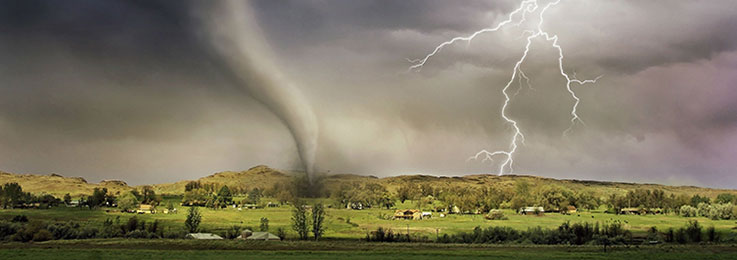A commercial roofing system has to withstand many forms of abuse throughout its lifetime. Major storms and other severe weather can result in hail damage, water damage, wind damage and a variety of issues that facility managers and business owners hate to deal with.
That’s why there’s no better time than the present to give your roof a bit of extra attention and preparation. This guide will help you understand the importance of commercial roof inspections and basic roof maintenance to protect against storm damage or address roof damage after the storm passes.
Preparing Your Commercial Roof for a Storm
If there’s a potentially damaging storm in the forecast, you should spend some time making sure your roof is ready to withstand the rough weather. Afterall, the roofing system is your building’s first line of defense, and even a small leak can cause hundreds (or thousands) of dollars’ worth of damages to your business.
When planning for severe weather, make sure you follow these steps:
Schedule a Roof Inspection
The importance of preventative maintenance cannot be overstated. If you haven’t done it already, find a trustworthy professional roofing contractor to inspect your commercial roof.
Keep in mind that it’s important to hire an experienced commercial roofer for this inspection, too. Just because you climb on your roof and don’t see anything out of the ordinary doesn’t mean there can’t be underlying issues. An untrained eye is likely to miss major points of vulnerability in your roofing system.
A professional will be able to tell you if there are any areas in need of emergency roof repair or roof replacement before the next storm moves in.
Address Necessary Repairs and Maintenance
Did the roofer‘s inspection reveal necessary repairs or maintenance?
If so, don’t ignore them!
If you don’t address the problem areas discovered during the inspection by making the proper roof repairs, you’re wasting money. After all, it’s not worth bothering with an inspection if you aren’t going to follow the subsequent recommendations.
Failing to fortify your commercial roof will leave your facility susceptible to more severe damage when a powerful storm does roll through, which means you’ll have to spend even more money down the road.
Check Roofing Equipment
Double-check any equipment or mechanical fixtures on your roof. For example, if your commercial building has an HVAC system installed on the roof, make sure the system is secure. Otherwise, this type of machinery can become loosened or detached during a heavy storm, causing serious damage or leaks.
Waterproof Your Roofing System
The majority of commercial facilities have flat roofs that utilize PVC, EPDM or TPO, and heavy rainwater during a storm on a flat roof has the potential to gather in large puddles.
Because of this, it’s important to waterproof with an appropriate roof coating, depending on your building’s type of roofing material. This will create a barrier between the water and your inner roof that keeps it from absorbing into the material or damaging it.
Prune or Remove Encroaching Trees
It’s common for a strong storm to knock down a few trees (or at least cause them to drop heavy branches). If there are any tall trees around your commercial building, prune old branches or cut them down (if they aren’t healthy). This will prevent the worst-case scenario of the tree falling on your building or dropping large branches onto your roof in strong winds.
Secure Loose Objects on the Property
Does your commercial property have any loose items, such as signage, products, tables, chairs, etc.? Move them inside or find a way to secure them. In severe storms with high winds, these items could end up damaging your building or roof.
What to Do After the Storm Passes
Once the storm has moved through, there are a few final things you should do to ensure your roofing system made it through the storm unscathed.
Schedule Another Commercial Roofing Inspection
It’s important to schedule a second inspection after extreme storms. Your roof may have been in good condition before the storm, but strong wind, rain, hailstorms, and flying debris can be cause for concern. A professional roofing contractor will be able to tell you if there are any areas that need some attention after the weather subsides.
If you’re worried about assessing potential damage immediately, you can visually survey your roof before the professional arrives. Look for the following things:
-
- Pooling water
- Cracks, holes, or rips in the membrane
- Missing shingles
- Gaps between roofing equipment and the roofing material
- Worn or broken flashing
- Sagging areas
These are some of the most common warning signs of bigger problems, and if you notice them, you’ll need to schedule a professional inspection as soon as possible.
Don’t Delay Roof Repairs
Again, don’t put off any necessary repairs that a professional commercial roofer finds. Delaying roof repairs only compounds the issues, making the job much more expensive later on, especially if the storm season is just beginning!
Find a Commercial Roofing Company to Help You Manage Storm Damage
If there is bad weather on the horizon and you’re worried about your commercial roof sustaining storm damage, make sure you get in touch with us right away. The professionals at TEMA Roofing Services will help you get your commercial roof ready for the storm and make sure it’s still in good condition after it passes.





